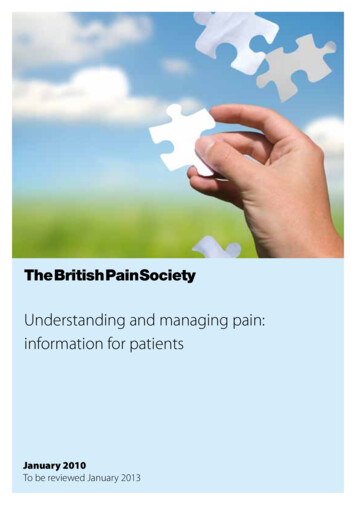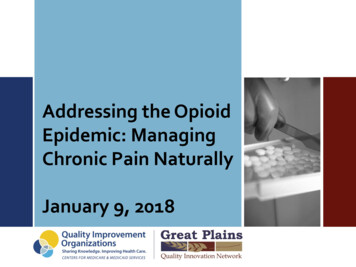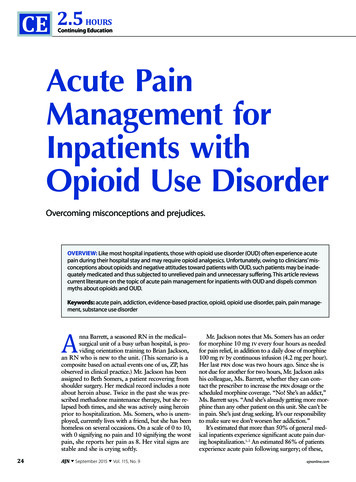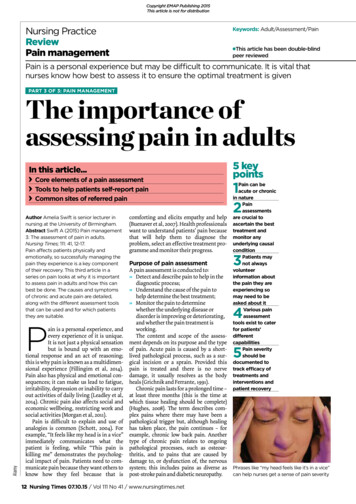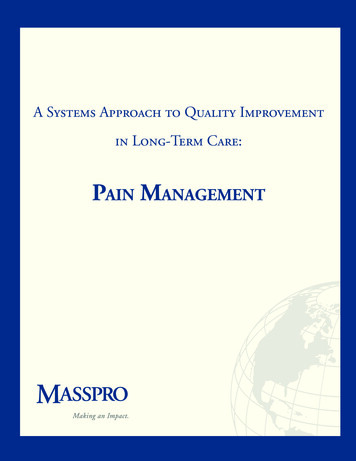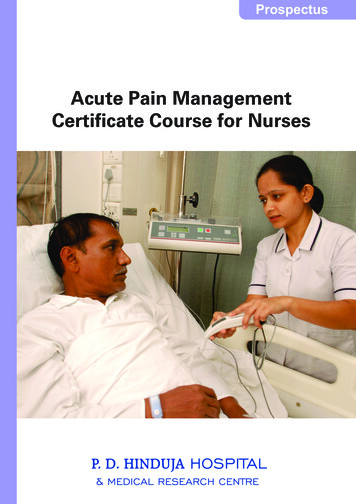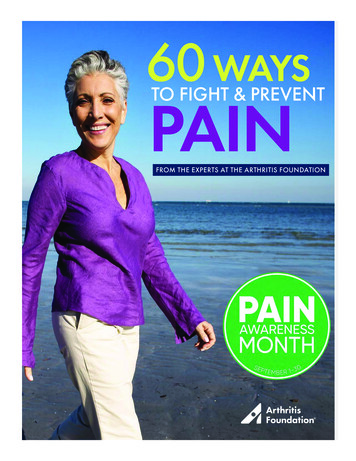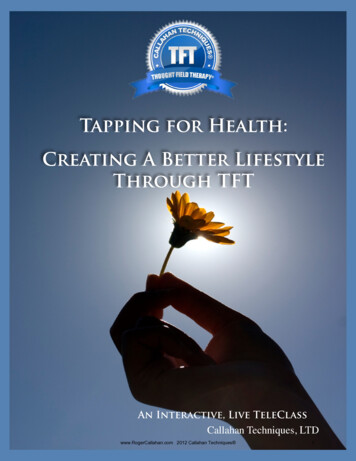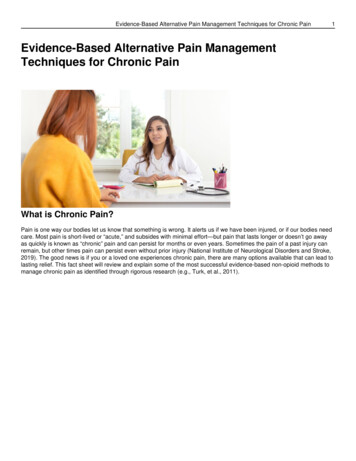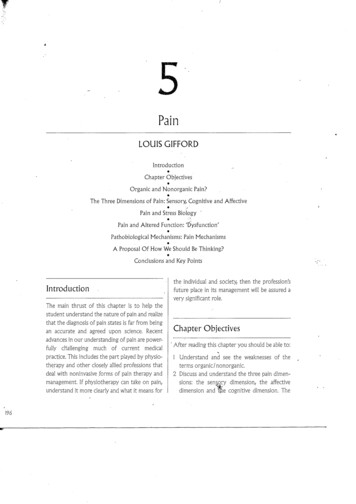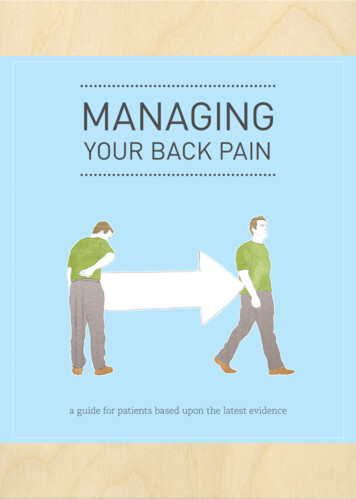
Transcription
MANAGINGYOUR BACK PAINa guide for patients based upon the latest evidence
WHAT DOWE KNOW? Back pain is very common and normally gets better over a fewdays or weeks. Pain may last for longer than a few weeks, or may come andgo. This does not mean your back problem is serious. Back pain is rarely due to serious disease or damage. Your spine is one of the strongest parts of your body and issurprisingly difficult to damage. The amount of pain felt is not related to the degree of damage– think of a paper cut! With the right information, support and treatment, mostpeople can manage their own back pain. Maintaining and then gradually increasing your daily activitycan help you to recover sooner.1
FINDING OUTWHAT IS HAPPENINGWhen you see your health professional, they will ask youquestions and examine you. Once they have checked that youdon’t have any serious damage or conditions they will oftenclassify your back pain as ‘non-specific’ back pain. This is verycommon and means that the exact cause of the pain is not clear.In most cases it is due to a muscle and/or ligament strain orsprain. 95% of all low back pain is ‘non-specific’.For ‘non-specific’ back pain it is very unlikely you will need anX-ray or scan. These tests won’t help us find a cause of your backpain or decide how to best manage your problem.It’s really hard to identify an exact cause of most common backpains. If this is the case it can be frustrating, but this is a goodsign that no serious damage or conditions are present. We don’t need to know the exact cause of most back painto be able to treat it.2
WHAT CAN YOU DOTO MANAGE YOUR PAIN?STAY ACTIVEYour pain might make this harder than normal, but we now knowthat maintaining and gradually increasing your daily activity canhelp you to get better sooner.Moving your back may hurt but this does not mean you arecausing more damage. Try to remember that “hurt is not thesame as harm.” Pain and damage are not the same thing.You may have to take things a little easier at first and graduallybuild up over a few days or weeks.Don’t stop doing your normal activities – just change the wayyou go about doing them. If you do have to limit some of youractivities, try to build them back into your life over a few days orweeks.3
STAYING AT WORK Try to remain at work, or get back to work as soon aspossible.You may need to talk with your employer about changing yourwork duties, hours and work space to allow for your recovery.AVOID PROLONGED BED RESTBed rest is not a treatment and can make you worse. By notmoving, your muscles and joints get weaker and stiffer and youlose your physical fitness. Don’t overdo it, but try to avoid long periods of inactivity.4
MEDICATIONTaking regular pain relief such as paracetamol is useful if itallows you to remain active. Don’t wait until the pain gets toomuch. If your pain is very bad, talk to your doctor about suitablepain relief.Medication will not increase your risk of damaging your back bymasking your body’s warning signals.HEAT OR COLDHeat or cold packs can help to give you some relief. You will haveto test which one works better for you.5
EXERCISE AND FITNESSRegular exercise helps to keep you and your back fit and healthy.Walking, cycling and swimming are popular, but it is importantthat you find an activity that you enjoy and that benefits you.This will help you to stay active long after you have recovered.CHANGE LIFESTYLE FACTORSCheck for everyday things that may be aggravating your back,such as repetitive and/or uncomfortable postures at work orhome. Experiment with different chairs, positions, and seatadjustments.Think about what postures make your pain better and use thisknowledge to help manage your pain.Remember a good rule for life is to not stay in one position formore than 20 minutes at a time6
REDUCE STRESS AND TENSIONYou may feel worried about your back. However this can causemore tension leading to more pain.You can’t always remove the cause of stress, but you can learnstrategies to reduce how it affects you. This may help reduce yourpain.Try to do something that helps you relax such as listening tomusic or imagining something calm. Like all activities, the moreyou practice being calm, the better you get at it. TRY THIS EXERCISE Find a comfortable position Focus upon your breathing Slow and steady breathing ‘Let go’ of tension as you breathe out This can take 10-15 minutes7
WHAT ELSE CAN YOU DOTO HELP YOUR PAIN?If you are a smoker, consider getting help to quit. It has beenshown that smoking can prolong your recovery.Eat a healthy diet and aim for a healthy weight. This can help toreduce the physical stress upon your back.8
COPING ORAVOIDINGPeople can often be described as either avoiders or copers in howthey think about and manage their pain.How you think about your pain can affect your recovery. This isgood news - you can ‘change your mind’ about how you manageand recover.THE AVOIDER: fears their pain and worries about the future thinks that pain means more damage rests and waits waits for someone else to fix it for themAvoiders tend to have pain for longer.THE COPER: focuses on getting better carries on living as normally as possible stays positive and active believes they can help themselvesCopers tend to get better faster and stay better for longer.9
WHEN SHOULD YOUSEEK HELP?These are very rare symptoms. Contact a doctor if you have anyof these: Recent difficulty passing or controlling urine. A change in sensation around your back passage orgenitals. Numbness, pins and needles, or weakness in both legs. Recent unsteadiness on your feet. Severe pain that gets worse over several weeks. You are feeling unwell with your back pain.If your pain continues to be a problem, discuss this with yourhealth professional as there are further treatment optionsavailable.10
KEY POINTSTO REMEMBER The back is strong and designed to move. Serious or permanent damage is rare. Hurt does not mean harm or damage. Most back pain settles with time. There are lots of things you can do to help. Maintaining and gradually increasing your daily activityand fitness can help you recover sooner.11
NOTES12
ACKNOWLEDGEMENTSThe Managing Your Back Pain booklet is a collaborative workdeveloped by health professionals across acute, community andnot for profit sectors in Southern Tasmania. We acknowledgethose who have contributed to this booklet through participationin: The Musculoskeletal Working Group, Tasmanian HealthOrganisation South Early Management of Low Back Pain project, Project Team Persistent Pain Resource Development project, Project TeamGraphic design & illustrations – Tom Smith // bluehat.com.auCopyright 2013 – Tasmanian Health Organisation SouthPermission to copy is granted provided the source isacknowledged
classify your back pain as ‘non-specific’ back pain. This is very common and means that the exact cause of the pain is not clear. In most cases it is due to a muscle and/or ligament strain or sprain. 95% of all low back pain is ‘non-specific’. For ‘non-specific’ back pain

